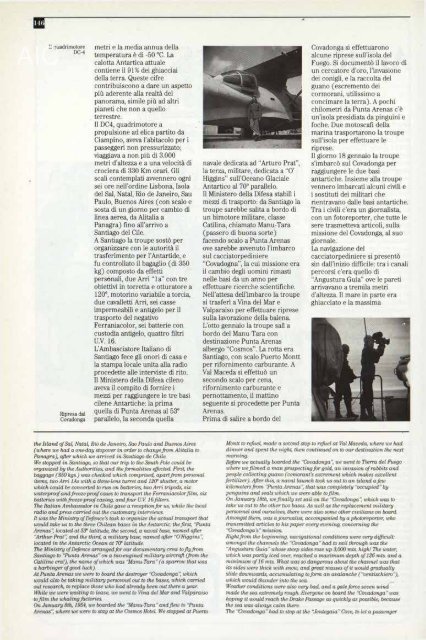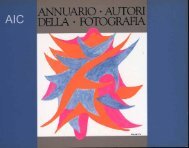ITALIANA - AIC Associazione Italiana Autori della Fotografia ...
ITALIANA - AIC Associazione Italiana Autori della Fotografia ...
ITALIANA - AIC Associazione Italiana Autori della Fotografia ...
Create successful ePaper yourself
Turn your PDF publications into a flip-book with our unique Google optimized e-Paper software.
<strong>AIC</strong><br />
Il quadrimotore<br />
DC-4<br />
Ripresa dal<br />
Covadonga<br />
metri e la media annua <strong>della</strong><br />
temperatura è di -50 °C. La<br />
calotta Antartica attuale<br />
contiene il 91% dei ghiacciai<br />
<strong>della</strong> terra. Queste cifre<br />
contribuiscono a dare un aspetto<br />
più aderente alla realtà del<br />
panorama, simile più ad altri<br />
pianeti che non a quello<br />
terrestre.<br />
Il DC4, quadrimotore a<br />
propulsione ad elica partito da<br />
Ciampino, aveva l'abitacolo per i<br />
passeggeri non pressurizzato;<br />
viaggiava a non più di 3.000<br />
metri d'altezza e a una velocità di<br />
crociera di 330 Km orari. Gli<br />
scali contemplati avvennero ogni<br />
sei ore nell'ordine Lisbona, Isola<br />
del Sal, Natal, Rio de Janeiro, Sau<br />
Paulo, Buenos Aires (con scalo e<br />
sosta di un giorno per cambio di<br />
linea aerea, da Alitalia a<br />
Panagra) fino all'arrivo a<br />
Santiago del Cile.<br />
A Santiago la troupe sostò per<br />
organizzare con le autorità il<br />
trasferimento per l'Antartide, e<br />
fu controllato il bagaglio (di 350<br />
kg) composto da effetti<br />
personali, due Arri "la" con tre<br />
obiettivi in torretta e otturatore a<br />
120°, motorino variabile a torcia,<br />
due Cavalletti Arri, sei casse<br />
impermeabili e antigelo per il<br />
trasporto del negativo<br />
Ferraniacolor, sei batterie con<br />
custodia antigelo, quattro filtri<br />
U.V. 16.<br />
L'Ambasciatore Italiano di<br />
Santiago fece gli onori di casa e<br />
la stampa locale unita alla radio<br />
procedette alle interviste di rito.<br />
Il Ministero <strong>della</strong> Difesa cileno<br />
aveva il compito di fornire i<br />
mezzi per raggiungere le tre basi<br />
cilene Antartiche: la prima<br />
quella di Punta Arenas al 53°<br />
parallelo, la seconda quella<br />
the Island of Sal, Natal, Rio de Janeiro, Sao Paulo and Buenos Aires<br />
(where we had a one-day stopover in order to change fremi Alitalia to<br />
Panagra), after which we arrived in Santiago de Chile.<br />
We stopped in Santiago, so that our trip to the South Pole could be<br />
organized by the Authorities, and the formalities effected. First, the<br />
baggage (350 kgs.) was checked which comprised, apart from personal<br />
items, two Arri lAs with a three-lens turret and 120' shutter, a motor<br />
which could be converted to run on batteries, two Arri tripods, six<br />
waterproof and freeze-proof cases to transport the Ferraniacolor film, six<br />
batteries with freeze-proof casing, and four U.V. 16 filters.<br />
The Italian Ambassador in Chile gave a reception for us, while the local<br />
radio and press carried out the customary interviews.<br />
It was the Ministry of Defence's task to organize the actual transport that<br />
would take us to the three Chilean bases in the Antarctic: the first, "Punta<br />
Arenas", located at 58? latitude, the second, a naval base, named after<br />
"Arthur Prat", and the third, a military base, named after "O'Higgins",<br />
located in the Antarctic Ocean at 70? latitude.<br />
The Ministry of Defence arranged for our documentary crew to fly from<br />
Santiago to "Punta Arenas"on a two-engined military aircraft (from the<br />
Catiline era!), the name of which was "Manu-Tara" (a sparrow that was<br />
a harbinger of good luck).<br />
At Punta Arenas we were to board the destroyer "Covadonga " which<br />
would also be taking military personnel out to the bases, which carried<br />
out research, to replace those who had already been out there a year.<br />
While we were waiting to leave, we went to Vina del Mar and Valparaiso<br />
io film the whaling factories.<br />
On January 8th, 1954, we boarded the "Manu-Tara" and flew to "Punta<br />
Arenas", where we were to stay at the Cosmos Hotel. We stopped at Puerto<br />
navale dedicata ad "Arturo Prat",<br />
la terza, militare, dedicata a "O'<br />
Higgins" sull'Oceano Glaciale<br />
Antartico al 70° parallelo.<br />
Il Ministero <strong>della</strong> Difesa stabilì i<br />
mezzi di trasporto: da Santiago la<br />
troupe sarebbe salita a bordo di<br />
un bimotore militare, classe<br />
Catilina, chiamato Manu-Tara<br />
(passero di buona sorte)<br />
facendo scalo a Punta Arenas<br />
ove sarebbe avvenuto l'imbarco<br />
sul cacciatorpediniere<br />
"Covadogna", la cui missione era<br />
il cambio degli uomini rimasti<br />
nelle basi da un anno per<br />
effettuare ricerche scientifiche.<br />
Nell'attesa dell'imbarco la troupe<br />
si trasferì a Vina del Mar e<br />
Valparaiso per effettuare riprese<br />
sulla lavorazione <strong>della</strong> balena.<br />
L'otto gennaio la troupe salì a<br />
bordo del Manu-Tara con<br />
destinazione Punta Arenas<br />
albergo "Cosmos". La rotta era<br />
Santiago, con scalo Puerto Montt<br />
per rifornimento carburante. A<br />
Val Maceda si effettuò un<br />
secondo scalo per cena,<br />
rifornimento carburante e<br />
pernottamento, il mattino<br />
seguente si procedette per Punta<br />
Arenas.<br />
Prima di salire a bordo del<br />
Covadonga si effettuarono<br />
alcune riprese sull'isola del<br />
Fuego. Si documentò il lavoro di<br />
un cercatore d'oro, l'invasione<br />
dei conigli, e la raccolta del<br />
guano (escremento dei<br />
cormorani, utilissimo a<br />
concimare la terra). A pochi<br />
chilometri da Punta Arenas c'è<br />
un'isola presidiata da pinguini e<br />
foche. Due motoscafi <strong>della</strong><br />
marina trasportarono la troupe<br />
sull'isola per effettuare le<br />
riprese.<br />
Il giorno 18 gennaio la troupe<br />
s'imbarcò sul Covadonga per<br />
raggiungere le due basi<br />
antartiche. Insieme alla troupe<br />
vennero imbarcati alcuni civili e<br />
i sostituti dei militari che<br />
rientravano dalle basi antartiche.<br />
Tra i civili c'era un giornalista,<br />
con un fotoreporter, che tutte le<br />
sere trasmetteva articoli, sulla<br />
missione del Covadonga, al suo<br />
giornale.<br />
La navigazione del<br />
cacciatorpediniere si presentò<br />
sin dall'inizio difficile: tra i canali<br />
percorsi c'era quello di<br />
"Angustura Guia" ove le pareti<br />
arrivavano a tremila metri<br />
d'altezza. Il mare in parte era<br />
ghiacciato e la massima<br />
Montt to refuel, made a second stop to refuel at Val Maceda, where we had<br />
dinner and spent the night, then continued on to our destination the next<br />
morning.<br />
Before we actually boarded the "Covadonga", we went to Tierra del Fuego<br />
where we filmed a man prospecting for gold, an invasion of rabbits and<br />
people collecting guano (cormorant's excrement which makes excellent<br />
fertilizer). After this, a naval launch took us out to an island a few<br />
kilometers from "Punta Arenas", that was completely "occupied" by<br />
penguins and seals which we were able to film.<br />
On January 18th, we finally set sail on the "Covadonga", which was to<br />
take us out to the other two bases. As well as the replacement military<br />
personnel and ourselves, there were also some other civilians on board.<br />
Amongst them, was a journalist, accompanied by a photoreporter, who<br />
transmitted articles to his paper every evening, concerning the<br />
"Covadonga's " mission.<br />
Right from the beginning, navigational conditions were very difficult<br />
amongst the channels the "Covadonga" had to sail through was the<br />
"Angustura Guia" whose steep sides rose up 3,000 mts. high! The water,<br />
which was partly iced over, reached a maximum depth of 126 mts. and a<br />
minimum of 16 mts. What was so dangerous about the channel was that<br />
its sides were thick with snow, and great masses of it would gradually<br />
slide downwards, accumulating to form an avalanche ("ventischiero"),<br />
which would thunder into the sea ^<br />
Weather conditions were also very bad, and a gale force seven wind<br />
made the sea extremely rough Everyone on board the "Covadonga " was<br />
hoping it would reach the Drake Passage as quickly as possible, because<br />
the sea was always calm there.<br />
The "Covadonga" had to stop at the "Jentegaia" Cove, to let a passenger









